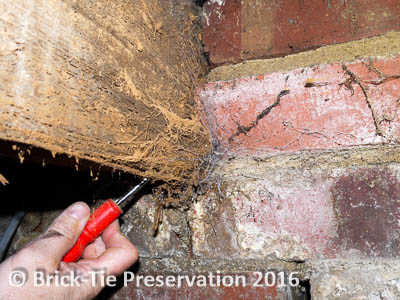Rising damp is a common problem in walls without an effective DPC and the presence of a DPC will almost always stop the problem. It’s merely the case of breaking the capillary pathways, which link masonry in the damp earth to masonry higher up; where we need it to remain dry.
How easy is it to interrupt that pathway?
Well here is an unusual example which is useful as a way of demonstrating what is happening when damp rises up a wall and what is required to stop it, though there’s a twist here.
The image was taken just this week at a chapel in Yorkshire, which my client is converting to a dwelling. I was asked to take a look and get to the bottom of the damp problem, which has caused lots of salting around the base of the walls over the years and some spalling of the brickwork.
As you can see the bottom few courses of brick are clearly damp and there a fair bit of salt contamination too. There’s a small section timber plate in the wall, which due to the dampness is slowly decaying. Note though, how the brickwork above the plate is free of visible dampness and is salt free.
Why?
The answer lies in the unique difference between masonry’s internal structure and that of timber. The masonry is porous; full of spaces and gaps, between the sand, the lime matrix and the clay in the bricks; these tiny voids form capillaries, through which moisture is drawn from the ground. Timber is porous too, in fact some timbers are known as ‘ring porous’ and you can blow air through them and almost breath through these, so why has the damp not just passed straight through the wood and above?
The timber has been flat sawn and in effect is laid with the longitudinal grain running perpendicular to the ground – water does not cross the grain very well at all and this is a great example of that. The wood has become moist though and is beginning (after 100 years), to rot. But it has still, despite being only 15mm thick and porous, interrupted the capillary pathways and acted as an organic DPC.
It’s no surprise that old bitumen DPCs still tend to work even after 70 or eighty years, if a piece of wood can do the same job and not rot after 100. I’m not suggesting we use wood for this job of course, but it illustrates the action of damp being wicked up a wall and also the resilience of wood against water, which is not under hydrostatic pressure, when across the grain.
This job is about to start a DryZone DPC in the lowest visible bed-joint, a DryBase sealed wall/floor junction and after cutting flush, a quick application of ProBor 20 to preserve the plate for another 100 years.. Thanks to BT Preservation that is.

